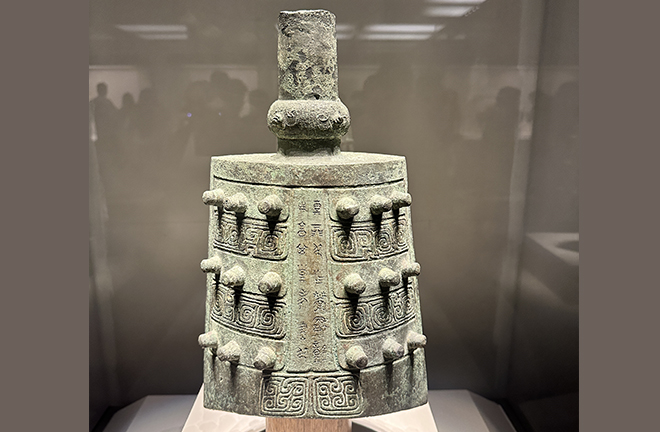Rite-music system as political philosophy since Zhou Dynasty

The “Zheng Bi Shu” bronze zhong (percussion instrument) from the late Western Zhou Dynasty Photo: Ren Guanhong/CSST
After overthrowing the Shang Dynasty, the Zhou rulers solidified the entire dynasty by creating an array of feudal states across the empire. Against this background, the Duke of Zhou initiated the development of the ritual-music system.
According to the Liji [a collection of texts describing the social forms, administration, and ceremonial rites of the Zhou Dynasty as they were understood in the Warring States and the early Han periods], “during six years he [Duke of Zhou] gave audience to all the princes in the Hall of Distinction; instituted ceremonies, made his instruments of music, gave out his (standard) weights and measures, and there was a grand submission throughout the kingdom.” It appears that the Zhou people sought to integrate the aesthetic value of the ritual-music system into the country’s budding political framework, elevating it to an important tool for highlighting political ideas, consciousness, and ethics. With the intervention of beauty and art, politics was no longer a naked means of education or regulation. From this point of view, the aesthetic system centered on ritual and music formed in the Western Zhou Dynasty achieved the perfect integration of aesthetics and politics, becoming the ideal goal pursued by subsequent rulers in governing the country.
The Zhou people regarded an elegant life as one lived in accordance with their system of rituals and music. This lifestyle implied the pursuit of rational order. The nobles of the Zhou Dynasty distinguished their social status, official position, and wealth through their involvement in ritual and music activities. In other words, through various forms of ritual and music observances, they exhibited taste and refinement distinct from everyday conduct—a way to underscore their distinctive status and political power. Consequently, they insisted on the normative nature of ritual-music activities to strengthen the internal rational order.
The ritual-music system not only involved etiquette and music, but also included other relevant factors such as behavior, speech, clothing, vehicle decorations, bronzes, patterns, architecture, and beliefs regarding heaven and earth, as evidenced by Zuo Zhuan [an ancient commentary on the ancient Chinese chronicle Spring and Autumn Annals]. According to this text, a king should not only set an example for all officials and future generations by promoting good virtues, but also exhibit his majesty in perceptual forms such as behavior, clothing, color options, and vehicle decorations. Therefore, “the roof of the Ancestral Temple should be constructed from thatch, and straw mats should be used as cushions for large carriages used in ceremonies. The gravy used for sacrifices should not be seasoned, and the grains used for sacrifices should be not processed. These codes demonstrate the virtue of frugality. Dresses, top hats, kneecaps, belts, skirts, shoes, hairpins, hanging ropes, hatbands, and headscarves are all used to highlight the laws of superiority and inferiority. Jade mats, scarves, scabbards, knife ornaments, belts, belt ornaments, streamers, and horse martingale are all used to show the etiquette of superiority and inferiority. The various patterns on ceremony dress represent noble literary talent. The five positive colors of green, yellow, red, white and black depict various images to identify the color of utensils. The various bells on chariots and horses aim to distinguish the sound, and the flags with the motifs of the sun, moon and stars are signals of light.”
The Liji also made an explanation of this point: “The style prized in conversation required that it should be grave and distinct. The demeanour prized in the court required that it should be well regulated and urbane; that at sacrifices was to be grave, with an appearance of anxiety. The horses of the chariot were to be well-paced and matched. The beauty of their bells was that they intimated dignity and harmony” (trans. James Legge). This exemplified the integration of aesthetics with politics, and symbolically represented the Zhou people’s establishment of a new ruling paradigm. This method of influencing dynastic rule through poetic rituals and music inspired Pre-Qin Confucianism and became the main ideological source of its political aesthetics.Edited by REN GUANHONG
Wang Yi is an associate professor from the Henan University of Technology.
Edited by REN GUANHONG
